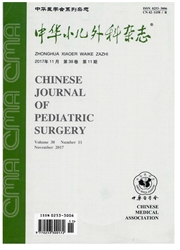

 中文摘要:
中文摘要:
目的研究Smads在正常和尿道下裂患儿包皮组织中的表达,探讨其在尿道下裂发病机制中的角色。方法收集拟行尿道下裂尿道修复术患儿术中切除的包皮组织(30例)和门诊包皮环切术中切除的儿童包皮(30例),采用免疫组织化学和实时定量聚合酶链反应(qPCR)方法检测两组包皮组织中Smad7、Smad3和Smad2的mRNA和蛋白质的表达变化。结果尿道下裂患儿包皮组织中Smad7、Smad3和Smad2mRNA表达较正常水平分别升高97.0%,22.8%和59.9%;且均有显著性差异(P〈0.05)。Smad7和磷酸化Srnad2/3蛋白表达于包皮皮下间充质细胞层,且在尿道下裂患儿包皮组织的表达较正常对照有显著升高趋势。结论根据结果我们初步认为,Smad作为细胞问信号传递蛋白参与了男性尿道的发育,而Smad7、Smad3和Smad2过表达可能是调控尿道下裂发生的重要因素。
 英文摘要:
英文摘要:
Objective To study the expressions ofSmad7, Smad3 and Smad2 in foreskin from children with hypospadias. Methods Penile foreskin tissues were collected from 30 children during repair surgery for hypospadias. The control foreskin tissues were collected from age-paired 30 children underwent circumcision. Real-time quantitative polymerase chain reaction (qPCR) and immunochemi- cal staining were employed to determine the mRNA expression and phosphorylated Smad7, Smad3 and Smad2 in foreskin tissues. Results The mRNAs of Smad7, Smad3 and Smad2 in foreskin tissues respectively increased by 97. 0%, 22. 8~.%0 and 59. 9% in hypospadias patients compared with those in control patients, and the difference between the 2 groups was significant (all P~0. 05). Meanwhile, the phosphorylated Smad7, Smad3 and Smad2 were mainly located in mesenchymal cells in foreskin, and their expressions were significantly increased in hypospadias compared with those in controls (all P%0. 05). Conclusions The increased expressions of SmadT, Smad3 and Smad2 are associated with hypospadias, which may play a role in the development of urethra and formation of hypospadias.
 同期刊论文项目
同期刊论文项目
 同项目期刊论文
同项目期刊论文
 期刊信息
期刊信息
